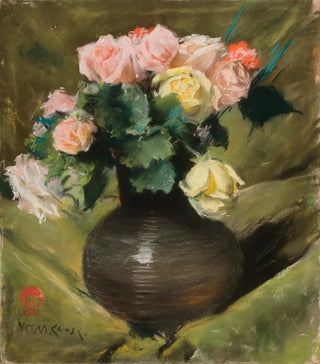Art print | Roses - William Merritt Chase


View from behind

Frame (optional)
William Merritt Chase’s captivating introduction
In the fascinating world of art, some works manage to capture the very essence of natural beauty. "Roses" by William Merritt Chase is a perfect example. This painting, imbued with delicacy and poetry, invites the viewer to immerse themselves in a lush garden where vibrant colors and subtle nuances of the flowers intertwine with striking harmony. Chase’s composition, both simple and refined, evokes an atmosphere of serenity, transforming the space it occupies into a true haven of peace. This piece does more than adorn a wall; it tells a story, that of an artist passionate about nature and the relentless pursuit of beauty.
Style and uniqueness of the work
William Merritt Chase’s style is characterized by an impressionist approach, where light and color play a leading role. In "Roses," each petal seems to vibrate under the effect of a soft, almost ethereal light, highlighting the most subtle details. The roses, with their shades ranging from pale pink to deep red, are depicted with such finesse that they almost feel tangible. Chase uses fluid and dynamic brushstrokes, giving his flowers a life of their own. His mastery of color and light creates an atmosphere that is both intimate and universal, where each viewer can find themselves. This painting is much more than a simple floral representation; it is a celebration of nature, a tribute to the fleeting beauty of roses.
The artist and his influence
William Merritt Chase, an emblematic figure of the American impressionist movement, knew how to leave his mark on his era through his boldness and innovation. Born in 1849, he was a pioneer in the use of color and light, influencing many contemporary and future artists. Chase also played a key role in art education, sharing his passion and expertise with generations of students. His unique approach to landscape and still life painting paved the way for a new understanding of the interaction between art and nature. "Roses" perfectly illustrates this vision, where each brushstroke bears witness to his commitment to the

Matte finish

View from behind

Frame (optional)
William Merritt Chase’s captivating introduction
In the fascinating world of art, some works manage to capture the very essence of natural beauty. "Roses" by William Merritt Chase is a perfect example. This painting, imbued with delicacy and poetry, invites the viewer to immerse themselves in a lush garden where vibrant colors and subtle nuances of the flowers intertwine with striking harmony. Chase’s composition, both simple and refined, evokes an atmosphere of serenity, transforming the space it occupies into a true haven of peace. This piece does more than adorn a wall; it tells a story, that of an artist passionate about nature and the relentless pursuit of beauty.
Style and uniqueness of the work
William Merritt Chase’s style is characterized by an impressionist approach, where light and color play a leading role. In "Roses," each petal seems to vibrate under the effect of a soft, almost ethereal light, highlighting the most subtle details. The roses, with their shades ranging from pale pink to deep red, are depicted with such finesse that they almost feel tangible. Chase uses fluid and dynamic brushstrokes, giving his flowers a life of their own. His mastery of color and light creates an atmosphere that is both intimate and universal, where each viewer can find themselves. This painting is much more than a simple floral representation; it is a celebration of nature, a tribute to the fleeting beauty of roses.
The artist and his influence
William Merritt Chase, an emblematic figure of the American impressionist movement, knew how to leave his mark on his era through his boldness and innovation. Born in 1849, he was a pioneer in the use of color and light, influencing many contemporary and future artists. Chase also played a key role in art education, sharing his passion and expertise with generations of students. His unique approach to landscape and still life painting paved the way for a new understanding of the interaction between art and nature. "Roses" perfectly illustrates this vision, where each brushstroke bears witness to his commitment to the






